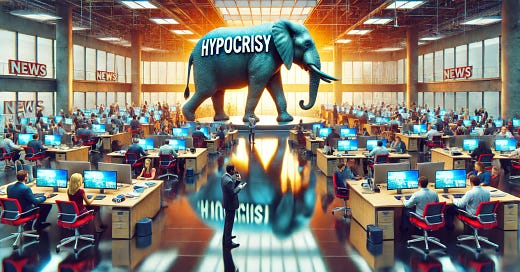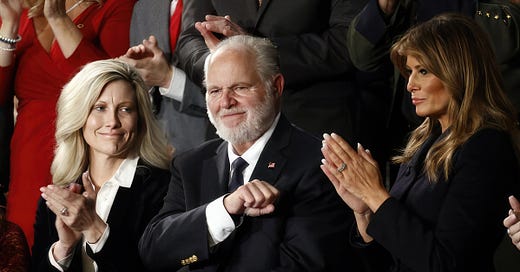

Discover more from @amuse
When Endorsements Meet Elitism: The Media’s Unspoken Rule of ‘Do as I Say, Not as I Do’
Newspapers’ practice of endorsing Democratic candidates reveals a double standard on political neutrality.
The Washington Post, The New York Times, and The Los Angeles Times pride themselves on upholding journalistic ethics that purportedly ensure impartiality. They demand that their reporters refrain from engaging in any activity that might give the appearance of political bias—no donations, no rallies, no overt displays of allegiance. Yet, until recently, these very publications, sanctimonious in their purported objectivity, have been all too comfortable endorsing political candidates. Such endorsements are the highest form of bias, a blatant declaration of preference wrapped in a veneer of editorial independence. The Los Angeles Times and The Washington Post have recently abandoned this farce, and I, for one, commend this decision. Let us dissect why their previous stances were not only hypocritical but actively undermined the core principle of journalistic integrity.
These three titans of journalism have long insisted on the importance of maintaining an unbiased front. They have crafted ethical guidelines designed to keep reporters above the political fray, much like a judge instructed to recuse themselves in cases of personal interest. The guidelines—prohibiting financial contributions to political causes, participation in campaign activities, and attendance at political events in anything other than a professional capacity—serve to preserve an image of neutrality. They are meant to shield both the journalists and their institutions from accusations of favoritism or, worse, collusion.
But it’s all too clear that these ethical rules, while imposed with great vigor on individual reporters, somehow did not apply to the institutions themselves. In endorsing political candidates, the editorial boards of The Washington Post, The New York Times, and The Los Angeles Times have essentially proclaimed, "Our newsroom will maintain objectivity, but our paper will not." The glaring double standard is impossible to ignore. How can a publication demand its reporters remain unbiased, while simultaneously endorsing Democratic candidates cycle after cycle? It’s akin to a preacher who rails against sin on Sunday only to indulge in every vice come Monday.
The practice of candidate endorsement has a long history at these newspapers, with The New York Times first endorsing Abraham Lincoln in 1860. Over time, their preferences became glaringly clear: since the mid-20th century, all three newspapers have displayed a marked tendency to endorse Democratic candidates, with The New York Times endorsing Democratic nominees in almost every presidential election since 1960. The Washington Post, too, has consistently favored Democrats since its entry into political endorsements in 1976, backing figures like Bill Clinton, Al Gore, and most recently Joe Biden. The Los Angeles Times, though slightly more balanced in its earlier days, also drifted predominantly towards Democratic endorsements as the political winds in California shifted.
The partisan tilt is unmistakable. Since 1960, approximately 90% of The New York Times' endorsements have gone to Democrats, while The Washington Post has endorsed Democratic candidates about 85% of the time. The Los Angeles Times, though a bit more balanced, still endorsed Democrats around 70% of the time since the 1960s. In practice, the editorial boards have taken on the role of kingmakers, wielding their platforms to influence the electoral outcomes under the guise of impartiality. It is an affront to the very idea of unbiased journalism, a Trojan horse of partisanship presented as a gift of informed guidance.
To put it plainly, this behavior reflects the elitist arrogance of the Democrat-aligned media establishment. It is the progressive elites, ensconced in their glass towers in New York, D.C., and Los Angeles, who believe they know best—not just for their readers but for the country at large. Their endorsement practices reveal a deeply ingrained belief that the American electorate needs to be nudged in the "correct" direction, a belief that aligns squarely with the ethos of the modern Democrat Party: top-down control, the subordination of individual thought to the wisdom of those who "know better."
The hypocrisy is staggering when one considers the rules applied to individual reporters. A New York Times journalist cannot attend a political rally for fear that it might suggest bias—even if attending merely out of curiosity. The same journalist is forbidden from making even a minor political donation. Yet the very paper they work for does not hesitate to publicly endorse candidates, making a grand spectacle of their political preferences every four years. If the rationale behind restricting individual journalists is to avoid even the appearance of bias, how does that square with the outright endorsement of one political party’s candidate time after time?
This hypocrisy hasn’t gone unnoticed by readers, and it’s a major reason public trust in the media has cratered. A 2024 Gallup poll revealed that public trust in mass media is now lower than that of Congress—a body so mired in dysfunction that its approval often hovers below 20%. It seems readers are keenly aware of the dissonance between what these newspapers preach and what they practice. Jeff Bezos, owner of The Washington Post, hit the nail on the head in a recent op-ed when he acknowledged the public’s perception of bias, stating, "Most people believe the media is biased. Anyone who doesn’t see this is paying scant attention to reality, and those who fight reality lose." Bezos has taken steps to course-correct, hiring more conservative voices and ceasing presidential endorsements, recognizing that endorsements do little but tarnish credibility and heighten perceptions of bias.
The editorial boards have long argued that endorsements are simply a matter of opinion, distinct from the "hard news" of their journalistic reporting. But anyone with a shred of political insight knows better. Endorsements, particularly from newspapers with such vast readerships, are not inert exercises of free speech. They influence, they persuade, and they signal. When the editorial board endorses a candidate, it cannot help but set a tone that trickles down through the entire organization—from the framing of stories to the tenor of opinion columns, to the questions asked (or not asked) by journalists. It creates an institutional culture that, consciously or not, biases coverage.
The decision by The Washington Post and The Los Angeles Times to cease endorsing presidential candidates is a step in the right direction—albeit a small one. True reform would require these institutions to stop masquerading as impartial arbiters altogether and admit their biases plainly. Until then, their claims of objectivity will remain dubious at best. By dropping endorsements, The Post and LA Times have at least tacitly acknowledged the hypocrisy in their previous practices. The New York Times, however, remains stubbornly unrepentant, continuing the charade that it is somehow possible to separate its editorial advocacy from its news coverage.
The partisan slant of these newspapers has always aligned with a particular view of America’s future—one where globalism and progressive social policies are the default, and dissent is not so much debated as dismissed. The alignment is not accidental; it reflects the worldview of the elites who run these newspapers. Historically, this has meant a consistent championing of Democratic causes, whether through endorsements or through biased coverage that subtly advances the narrative of one party over the other. These papers have long lambasted Republicans, especially those aligned with America First policies, labeling them as "threats to democracy" or painting their concerns as unfounded conspiracies. Meanwhile, the failures and ethical lapses of Democrat leaders are routinely underplayed or spun with euphemisms that soften the impact.
To be sure, legal immigration, fiscal prudence, and a measured foreign policy are principles that many conservatives endorse—principles that have broad appeal across the electorate. But the endorsement machinery of these major newspapers has never been interested in nuance or balance. Instead, their endorsements—and the editorial stances they reflect—serve to anoint Democratic leaders who are viewed as suitable by the establishment, whether or not they represent the broader interests of the nation.
The time for hypocrisy is over. It is refreshing, even if rare, to see some of these publications begin to align their practices with their stated ethical commitments. The Washington Post and Los Angeles Times have taken steps to bridge the gulf between their own ethical guidelines and the actions of their editorial boards, and this should be recognized as progress. It’s not nearly enough to restore the credibility lost over decades of partisan advocacy disguised as public service, but it is a step. The New York Times would do well to follow their lead—or at least drop the charade of impartiality altogether. For the press to regain its lost credibility, it must choose: either abide by the standards you impose on your journalists, or admit openly that the days of unbiased reporting are long behind us.
















